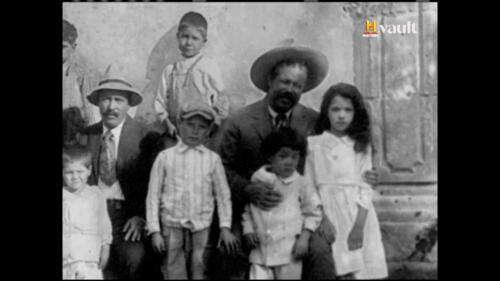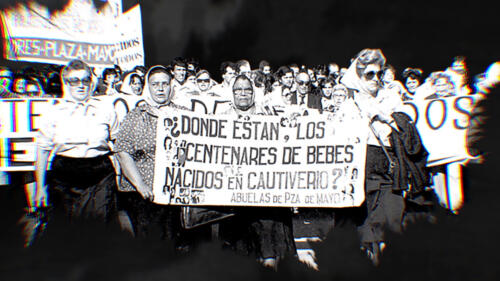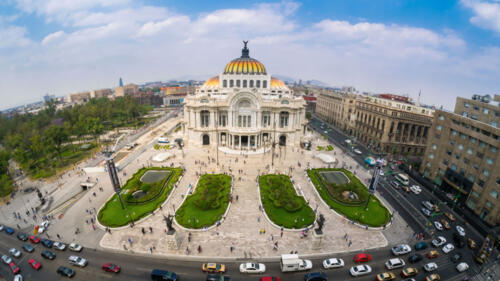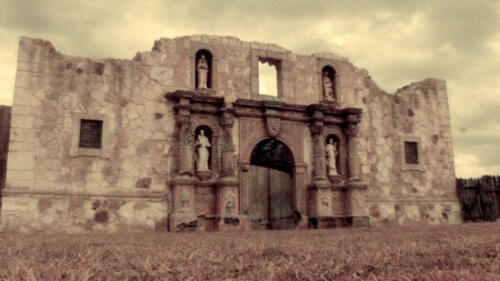Latin American & Caribbean History
Latin America encompasses Spanish- and Portuguese-speaking countries, including all of South America as well as Mexico, Central America and islands of the Caribbean. Latin American history saw thriving Indigenous cultures overtaken and colonized by the Spaniards and Portuguese between the 15th and 18th centuries, followed by independence movements in the early 19th century.
Featured Overview
Learn more about the history of Pancho Villa & The Mexican Revolution.
3:24m watch

Getty Images
Featured Overview
Learn more about the history of Pancho Villa & The Mexican Revolution.
3:24m watch
Start Here

Before Fidel Castro and the Cold War chill, America and Cuba shared close economic and political ties.

For decades, the Mothers and Grandmothers of the Plaza de Mayo have demanded answers.

A coming-of-age adventure through five South American countries set Che Guevara on the path to becoming a Marxist revolutionary.

Most may not think of Mexico as contributing to the Allied effort, but it contributed key resources, as well as fighting power.
Mexican Independence
Struggle for Mexican Independence
8 U.S. states exist on land that used to belong to Mexico. Learn more about Mexico's history!
3:34 watch

3 Key Independence Movements
Explore All Related Topics

Marley hoped the star-studded concert, held in Kingston, Jamaica in 1978, could help bring stability and peace to a divided, violence-stricken country.

Ernesto Che Guevara was a prominent communist figure in the Cuban Revolution (1956–59) who went on to become a guerrilla leader in South America. He was executed by the Bolivian army in 1967, and his death turned him into a martyred hero by generations of leftists worldwide.

Lincoln wanted to end slavery—but wasn’t keen on integrating African Americans into US society. His first attempt to send them offshore proved disastrous.

Before Fidel Castro and the Cold War chill, America and Cuba shared close economic and political ties.

Pushing back aggressions by Europe's greatest powers, Haiti's 'founding father' set the stage for the world's first sovereign Black state.

The Cuban Revolution was an armed uprising led by Fidel Castro that eventually toppled the brutal dictatorship of Fulgencio Batista by 1959.

The assassination of “las Mariposas” (“the Butterflies”) fueled public outrage against one of the longest and most ruthless regimes in modern history.

During World War I, Denmark finally sold Saint Thomas, Saint John and Saint Croix to the U.S. for $25 million in gold coin.

A coming-of-age adventure through five South American countries set Che Guevara on the path to becoming a Marxist revolutionary.
Human Rights Organization, Las Abuelas de Plaza de Mayo, fight to find their grandchildren who were kidnapped by Argentina's Authoritarian government in the 1970s.
2:05m watch

For decades, the Mothers and Grandmothers of the Plaza de Mayo have demanded answers.

Unlike the northern free states, Mexico didn’t agree to return people who had fled slavery.

General Pinochet’s agents hunted down Chile’s former Ambassador in the first state-sponsored international terrorist attack on U.S. soil.

Las soldaderas took on a range of roles from providing domestic support to dressing as men and leading troops into combat.

In the Mexican-American War, Mexico faced an enemy that was coming into its own as a military power.

'We should not play soccer amid the concentration camps and torture chambers,' wrote proponents of an international tournament boycott that year.

The 'Dance of the 41' changed the way that Mexico interpreted gender and sexuality forever.

In 2019, the island nation long ruled by dictator Fidel Castro and his family, got a new leader: Miguel Díaz-Canel.

Approximately 700 miles of barbed wire, chain link, post-and-rail and wire mesh fencing has been erected along the border.

Since the mid-19th century, Latino Americans have endured injustices ranging from school segregation to mob violence to mass deportations.
8 U.S. states exist on land that used to belong to Mexico. Learn more about Mexico's history!
3:34m watch
Che Guevara believed that communism would save the impoverished people of Latin America. Learn more about how he became a revolutionary icon of the anti-establishment in this video.
3:53m watch

After World War II, many Nazi war criminals changed their identities and escaped across the Atlantic. Only some were captured and brought to justice.

A new report provides insight into the amazing graveyard of fossilized whale skeletons unearthed during the construction of a Chilean highway.

As Mexico celebrates Revolution Day (Día de la Revolución) today, get the facts on one of history’s most convoluted conflicts.
It has become the site and symbol of the battle for Texan independence, but there is much more to the story. Find out why Americans will always remember the Alamo.
2:33m watch
Discover the Rapa Nui people of Easter Island and the mysterious stone Maoi that dot the island.
4:06m watch

Mexico was first populated more than 13,000 years ago before the Spanish conquered and colonized the country in the 16th century. In 1810, Miguel Hidalgo y Costilla, a Catholic priest, launched the Mexican War of Independence when he issued his Grito de Dolores, or “Cry of Delores.”

From the stone cities of the Maya to its conquest by Spain and its rise as a modern nation, Mexico boasts a rich history spanning more than 10,000 years.

History Early History Before the arrival of Spanish settlers to the area, Zacateco, Caxcán and Guachichile natives inhabited the region. Because the exact history of Zacatecas’ indigenous tribes is uncertain, the date of the area’s first settlement rema...

History Early History One of the most advanced indigenous cultures of the ancient Americas, the Mayans began as hunter gatherers and migrated into the Yucatán around 2500 B.C. During the pre-classic period (500 B.C.-250 A.D.) they appeared in Quintana R...

History Early History During the pre-Hispanic period, the region that now constitutes modern-day Veracruz was inhabited by four indigenous cultures. The Huastecos and Otomíes occupied the north, the Totonacas resided in the north-center, and the Olmecs,...

History Early History Archaeological evidence reveals the presence of human life in Tlaxcala as early as 10,000 B.C., when nomadic hunters and gatherers roamed the region. The first people to settle the land, however, were the Quinametin, who were later...

History Early History According to archeological evidence, nomadic tribes may have occupied the region as early as 6000 B.C. The first settlements are thought to have occurred around 4000 B.C. Tamaulipas was originally populated by the Olmec people and ...

History Early History Beginning around 1500 B.C., the Olmec civilization established itself in Tabasco, reaching its cultural and economic peak around 500 B.C. The Olmecs were noted for their superb stone carvings, which ranged from small, finely detail...

History Early History Although architectural evidence suggests that Sonora had permanent settlements as far back as 1500 B.C., the largest known indigenous groups were the Yaquis and the Mayos, who flourished around 1300 A.D. and established agriculture...

History Early History Before the arrival of the Spaniards, Sinaloa was inhabited by six major tribes of hunters and gathers: the Cahita, Tahue, Totorame, Pacaxee, Acaxee and Xixime. The Acaxees lived in rancherías (settlements) dispersed throughout the ...

History Early History While scant information exists on the state’s pre-Hispanic era, the Huastecos, Chichimecas and Guachichile Indians are believed to have inhabited the lands that now comprise San Luis Potosí as far back as 10,000 B.C. Their descenda...

Querétaro is a small Mexican state known for launching the Mexican War of Independence and for the manufacturing companies that power its economy today.

History Early History Cholula, the most important settlement of ancient Puebla, was established between 800 and 200 B.C. and is considered the oldest continually inhabited city in Mexico. By 100 B.C., the Olmecs had developed Cholula into one of Mexico’...

History Early History Between approximately 1500 and 500 B.C., the Zapotecan city of San José Mogote in what is now the state of Oaxaca was the largest and most important settlement in the region. Historians estimate that during the pre-colonial period,...

History **Early History **Anthropological and archeological evidence suggests that early nomad hunters and gatherers arrived in the area now known as Nuevo Leon as early as 8900 B.C. The state’s primary source of pre-Hispanic relics near Mina has yielde...

History Early History Although humans may have settled in Nayarit as early as 5,000 B.C, the first known civilization in the region, the Cora, appeared sometime around 400 A.D. Concentrated on the Nayar plateau of the Sierra Madre Occidental, Cora socie...

History Early History Human settlements in Morelos date back as far as 2000 B.C., when Toltec groups began farming the land. Around 600 A.D., Xichicalco became the region’s largest settlement and, according to some historians, the first society to worsh...

History Early History Numerous indigenous groups have inhabited the Michoacán area during the past 6,000 years. These groups predominantly settled in the basin of the Chapala and Cuitzeo rivers and include the Nahuas, Otomies and Matlazincas. The most d...

History Early History Beginning as early as 5,000 B.C., the central valley of Mexico was home to several different civilizations, notably the Olmecs and Toltecs. The Olmecs, often considered the mother culture of later Mesoamerican civilizations, flouri...

History Early History Nomadic tribes moved through Jalisco 10,000 to 12,000 years ago, as testified by the bones, projectile points and small tools they left behind. There is some evidence that they were passing from the north to the south, following la...

Hidalgo Today Industrial development has flourished in Hidalgo over the last few decades; textiles and cement products are currently the state’s primary exports. The state’s mines yield valuable metal ores such as manganese, zinc, iron, copper, gold and...

History Early History Evidence of human presence in Guerrero dates back to 300 B.C. when the Olmeca people inhabited central and southern Mexico. Even though the Olmeca primarily occupied Tabasco and Veracruz, their influence extended into modern-day Gu...

History Early History The first known human settlement in Guanajuato existed between 500 and 200 B.C. near Chupicuaro. The group is believed to have been fairly large and agrarian, growing maize along with other crops. Clay figurines from this culture, ...

History Early History Very little information exists about Durango’s pre-colonial past. It is speculated that the nomadic Nahoan Indians drifted down from the northern part of the continent (present-day United States) two millennia ago and roamed the ar...

Mexico City, Mexico’s largest city and the most populous metropolitan area in the Western Hemisphere, is also known as Distrito Federal, or the federal district. It is the country’s economic and cultural hub, as well as home to the offices of the federal government.

History Early History Little is known about Colima’s early history except that the Otomi, Nahuatl, Tolteca, Chichimeca and Tarasca cultures flourished there between approximately 2000 B.C and 1000 A.D. When the Spanish arrived in the area around 1525, m...

History Early History About 12,000 years ago, Nomadic hunters entered this region, which once included South Texas. Archeological evidence suggests that early hunter-gatherer cultures evolved into fixed societies that engaged in agriculture and fishing ...

History Early History When the Spanish first arrived in Chihuahua, more than 200 indigenous groups, including Native Americans, already inhabited the area. Although little of this period’s history is recorded, archeologists have found evidence of inhabi...

History Early History Chiapa de Corzo, a Mayan settlement in the center of Chiapas, shows evidence of human occupation since 1400 B.C., though little is known about the inhabitants of that area. Around 600 A.D., the Mayan city of Palenque was establishe...

History Early History Baja California Sur was inhabited as early as 11000 B.C. Nomadic tribes left behind artifacts such as arrow heads and Clovis points, which have been discovered in the northern part of the state. Primitive paintings dating to 1700 B...

History Early History Before the Spaniards arrived, the peninsula of Baja California was inhabited by three major ethnic groups: the Cochimí in the north, the Guaycura in the central section and the Pericú on the southern cape. Archaeological artifacts ...

Early History The indigenous groups of this region included the Caxcanes farmers in the southwest, the nomadic Zacatecos in the north and the warlike Guachichiles in the east. The town of El Ocote, inhabited as early as 300 A.D. was the main pre-hispani...

History Early History Pre-Mayan cultures inhabited the Yucatán Peninsula as early as 3000 B.C. During the 10th century, a Mayan group known as the Itzáes migrated into the area and built the cities of Coba, Xcaret, Xel Ha and Tulum. They also founded Ch...

History Early History Although pre-Mayan cultures inhabited the area of Campeche as early as 3000 B.C., relatively little is known about them. The Mayans, in contrast, left extensive evidence of their civilization, which originated on the Yucatán Penins...

Battle of San Jacinto: Background After gaining independence from Spain in the 1820s, Mexico welcomed foreign settlers to sparsely populated Texas, and a large group of Americans led by Stephen F. Austin (1793-1836) settled along the Brazos River. The A...

History Early History The Olmecs, Mexico’s first known society, settled on the Gulf Coast near what is now Veracruz. Remembered for the giant head sculptures they carved from native stone, the Olmecs had two main population centers: San Lorenzo, which f...

Rafael Trujillo (1891-1961) was a Dominican politician and general who ruled the Dominican Republic as dictator from 1930 until his assassination in May 1961. While in power, he led a brutal regime.

Pancho Villa (1878-1923) was a famed Mexican revolutionary and guerilla leader. He joined Francisco Madero’s uprising against Mexican President Porfirio Díaz in 1909, and later became leader of the División del Norte cavalry and governor of Chihuahua. A...

The Mexican Revolution, also known as the Mexican Civil War, began in 1910, ended dictatorship in Mexico and established a constitutional republic. Discover the timeline, the leaders involved and how the revolution started and ended.

Easter Island, located about 2,300 miles off Chile in the South Pacific Ocean, is known for its nearly 900 giant stone statues that date back several centuries.

The Treaty of Guadalupe Hidalgo in 1848 ended the Mexican-American War, with much of the current U.S. Southwest ceded to the United States from Mexico.

Augusto Pinochet was a Chilean general who led a 1973 coup to become president. He was charged with human rights abuses following the end of his dictatorship.








